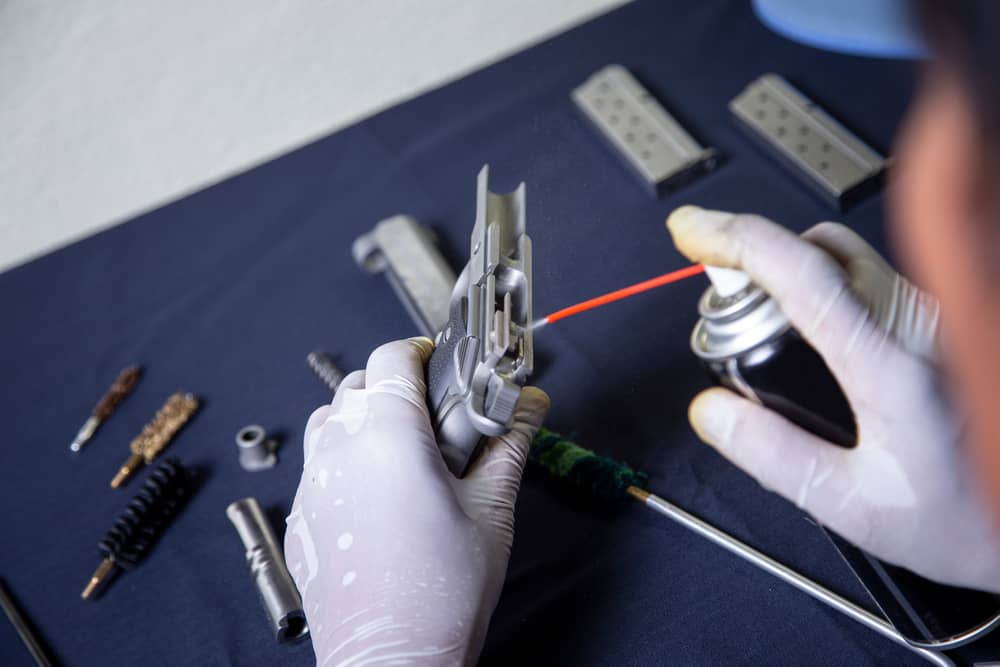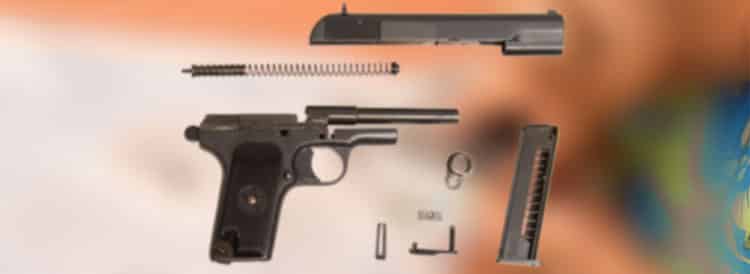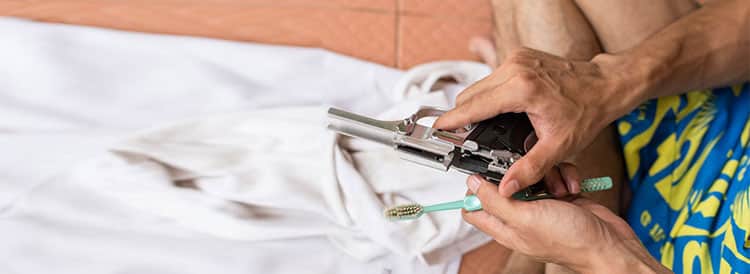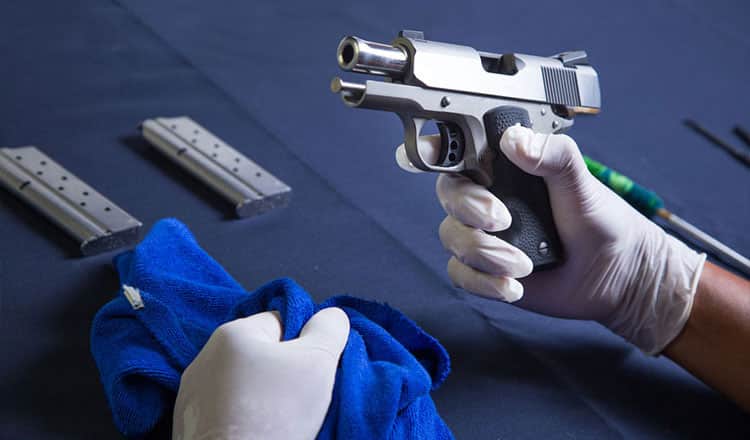Okay, so you’ve legally purchased a new handgun after going through lessons about learning how to shoot a gun.
You have also become well-acquainted with when it should be rightly used and the proper maintenance that must be adhered to generally.
Well, in this article we are going to focus on the latter, more specifically, the cleaning aspect.
Before going deep into the cleaning process of how to clean a handgun, you need to understand the idea of keeping and managing a defense tool.
Because your handgun requires responsibility and attention from you so there is no room for any tragic mistakes.
This means that asides from the regular cleaning of your handgun, you must ensure that the tool is not kept carelessly afterward.
You must consider how it is kept away, who else has access to it, how you can safely transport it if needed, where the ammunition is stored, legitimate documents or local license, and other related safety measures that are involved.
If you are reading this article then you are either curious about the proper things to be done when handling a handgun or what to clean your gun with exactly.
Read on to find out how to clean handguns the best way.
A Beginner’s Guide On Cleaning Handguns

Why Should You Get Your Gun Cleaned?
Handgun cleaning is one aspect of gun maintenance as there are many others. It is relatively important because it helps promote the weapon’s durability and sometimes its effectiveness.
Leaving a handgun in a mess from time to time ultimately portrays a sense of irresponsibility on the user’s end.
It may even add to the compromise of the owner’s permit if found in a non-ideal location or in a poor and unkempt condition.
So, yes! Even the act of cleaning a tool such as a handgun is important.
Always remember that this is not just for making your handgun look good but also for the protection enhancement concerning your legal rights, as this will show that you are disciplined enough to keep a weapon around.
How Often Should You Clean?
Perhaps you have been in possession of a handgun for a while now but wondered whether and how regularly should you clean the gun.
In the common sense of approaching this thought, one must clean his/her handgun based on its usage frequency.
After touching the gun it is left with acidic oil which comes from your skin. This acidic oil from our skin discards the defensive weapon oil layer applied after you may have initially cleaned it.
Apart from the skin oils, if you keep your gun in the cabinet, oils used to clean the gun previously still evaporates, or get dried up by dust.
Therefore, it is advisable to take out your shotgun once in a while to inspect and do a rapid wash appropriately.
There are several firearms each with its particular level of maintenance. As for a handgun, you do not have much work to do as compared to cleaning a rifle or other hunting firearms.
However, cleaning this kind of weapon requires more than just the surfaces being neat.
Some handguns are shot using corrosive ammo and it turns out that corrosive ammunition doesn’t take much time to rot out a bore.
Consequently, if your handgun typically gets corrosive ammo fired out from it, you must equally get the area well-cleaned up.
Failure to do this could cause both expensive and dangerous problems. Keep in mind that this is not just a suggestion.
If you are not thorough about knowing how to clean your gun, and how often you should clean it, it will get ruined easily.
What Should I Use to Clean My Gun?

Now, this question can be answered from two perspectives. The first is for occasions regarding a quick clean of the handgun from time to time while the second is based on a monthly cleaning routine during a mild climate with average weather.
For fast clean-ups, all you need is some ordinary cleaning supplies such as a good, neat patch, some oil, and a rag to sponge the exterior of your handgun
You might also want to reintroduce the defensive oil film with the aid of a lenient brush.
Here, you will need to get a proper and complete cleaning kit for the handgun to give a much better cleaning exercise to the weapon. A basic set of a gun cleaning kit includes.
- Cleaning solvent
- Cleaning rod
- Gun oil (or different suitable lubricants)
- Bore sight cleaning brush or bore brush
- Patches
- Cotton swabs
- Nylon cleaning swabs
- Microfiber cloths (like a rag)
- Flashlight
Why You Need a Gun Cleaning Kit?
There are a few times you would need to give an out-and-out cleaning to your weapon and this can be achieved by virtue of a gun cleaning set.
During very humid periods, you will have to inspect your gun more than once a month. And to do that, having your kit is always better.
As mentioned earlier, all the items in a gun cleaning kit can be used for a better cleaning exercise occasionally but this does not mean you are limited from doing this as often as you want.
If you cannot afford to buy a full kit at once, it is a good idea to simply assemble all the basic items that I listed above and keep them in a storage container with little ventilation, as experts recommend.
So, How Do You Clean a Handgun?
Now that you are well-acquainted with the conventional reasons and criteria for cleaning a gun, the next factor to consider is instructions on cleaning a handgun.
You don’t need to feel overwhelmed by all the necessary attention and requirements to give maintain your gun. The cleaning procedure is actually simple and fun to do once you get hang of it!
Here’s how to clean and oil a handgun the proper way:
1. Choose a Suitable Place

Whether you’re cleaning the semi-auto rifle or the revolver, you need to go to a warm and well-ventilated room where the handgun will eventually reach room temperature and clean it there.
Just use a led flashlight in a dim room to initially inspect the gun.
All traces of the rust will become prominent against the dark-colored surface of the gun.
2. Unload the Gun

Before you begin cleaning you have to unload the gun totally. This must be done meticulously, and always double-check to ensure it is completely unloaded before you clean.
To do this, open the chamber and look through the barrel thoroughly to confirm that no rounds are still present inside.
You might end up seeing see one more in the chamber or caught up in the barrel. Handle your firearms carefully as the US government has a strict gun policy.
3. Disassemble It as the Marker Suggests

Every gun should have its manufacturer’s signature and recommendation for instructions and product references.
Check the owner’s manual for the procedure on how to disassemble the handgun if you have not done this before.
You will be able to guide yourself through the detachable parts of the weapon and see the areas that can be untidy.
For handguns particularly, disassembling is straightforward but can be tricky too.
The steps below have been provided for reference to the common process of separating handgun components.
- Start by pushing the takedown latch downwards.
- Remove the recoil bar with the captivated spring.
- Detach the barrel from the rear slide rails.
- Set the rear slide-cover plate free by pushing the firing pin.
- Extract the striker. You will see its back side (and the pin) once the plate is out.
- Take out the pin that fastens the extractor.
- Remove the extractor as well.
- The small barrel of the pin safety can be removed with the spring inside.
- You can also remove the slide step lever after dismantling the striker, spring, and spring cups from the firing pin.
- Detach the triggering sub-frame too if need be.
After carefully following the steps above, you should have utterly disassembled your handgun and observed the parts that may need casual cleaning.
4. Clean, Scrub and Lubricate the Barrel

To easily get this part done, use the patch holder with the right amount of cotton swabs on the cleaning rod to soak the bore.
Note that for a suitable clean, push a solvent-soaked patch inside the bore and take it out from the other end.
Use a muzzle guard (if available) to keep the rod from hitting the muzzle to prevent feasible malfunction.
Doing this repeatedly for about 5 times will loosen any unwanted fragments or debris.
Once you notice that the cotton patches come out neat after subsequent re-runs in the bore, repeat the process once more but with a dry patch to make the bore dry.
After you have clean the barrel, lubricate it by attaching another set of cotton swabs to the cleaning rod and putting some drops of gun lubricants (oil) on the patch.
Push it through the bore likewise as done earlier to leave a light coating of gun oil inside the bore.
5. Clean and Lubricate the Gun’s Action

This process is to be carried out with a solvent. On a soft brush, apply the solvent on all parts of the action.
Apply lubrication lightly. This usually helps to prevent rust from occurring easily. When you have adequately oiled the gun’s action, wipe them dry with microfiber cloths.
6. Wipe the Gun Thoroughly
Finally, use the microfiber (or lustre) cloth to wipe down the entire handgun.
In case you do not have a cloth designated for wiping the gun then old t-shirts or socks can be used as an alternative.
This last procedure will further eliminate the remaining debris including fingerprints.
How to Clean a Handgun: Caution and Safety Rules
Here are some important things to consider as regards the precautions for cleaning your handgun.
- Unload your handgun completely. Try to check thoroughly for rounds that may be stuck somewhere.
- Keep the muzzle pointed toward a safe direction where you wouldn’t want a bullet to penetrate.
- Do not try to modify the gun or replace components to your own preference. Chances are you will end up ruining it because of a deviation from the normal mechanism.
- Ensure where you are doing the cleaning is noise-free. Ultimately, avoid all forms of distraction.
- Use eye protection during the process if possible. This will aid against a splash of lubricants or a sudden hit of small gun components (like springs) that may displace.
Gun Cleaning Instructions Continue…The Maintenance
Only knowing how to clean a handgun isn’t enough. You must also have adequate knowledge of how to properly maintain one after you finish cleaning your gun.
If you come across defects or signs of wear while you are cleaning your gun, take it to a gunsmith for professional treatment. This usually occurs as a result of frequent exposure or violent impacts on its surface.
Make sure you familiarize yourself with the characteristics of your handgun’s model.
If you have a manual then this should be much simpler. The essence is for you to fully understand the capabilities of your weapon and how to handle it effectively.
All necessary information about cleaning your gone and its relative maintenances have been elaborated above.
I know you may or may not have thought that cleaning your handgun could actually promote its lifespan significantly but what’s certain is that now you have become well-learned about this exercise.
Just do yourself a favor by always remembering to go over the rules and procedures every time you want to clean your gun until it becomes part of you.
You never can tell when you can apply the knowledge of how to clean a gun extensively for others to be aware too.
FAQs
How Often Do You Need to Clean a Handgun?
It is recommended to clean your handgun after every use. Depending on the type of ammunition you are using, you may need to clean your handgun more often than others.
Make sure to follow your gun manufacturer’s instructions.
What Type of Cleaner and Lubricant Should I Use When Cleaning My Handgun?
It is important to use a lubricant designed specifically for handguns. A gun cleaning solvent and lubricant, such as Hoppe’s No. 9 or Ballistol, are good options.
Avoid WD-40 and motor oil as these can damage the finish of your handgun.
Should I Use Compressed Air While Cleaning My Gun?
No. Compressed air is effective for removing dust and dirt from hard-to-reach areas, but it has the potential to push debris deeper into the action and cause damage or malfunctions.
Use cleaning patches or a bore snake instead.









Leave a Comment